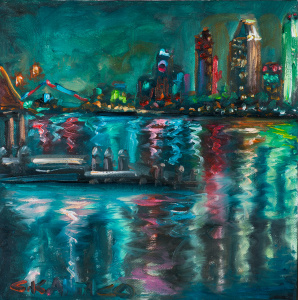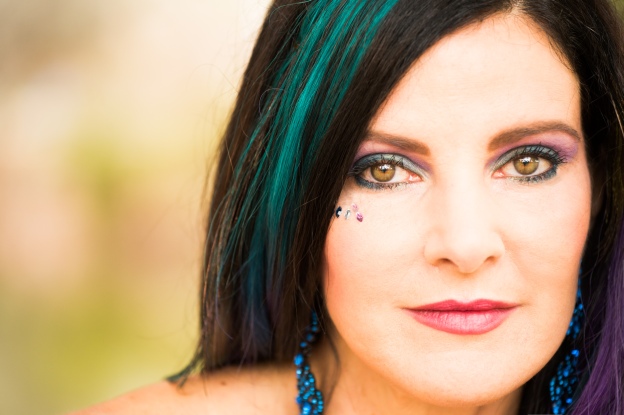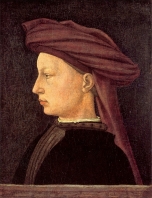The unique nature of an artist can be considered art itself. What sets great artists apart may not be their talents but their circumstances. While we know much of our destinies are determined by the decisions we make, remnants of happenstance hover over many of the artists we know and love.
No one understands this better than Concetta Antico, who, in 2012, received news that would change her life and send her already successful art career into high gear.
The Making of an Artist
To Concetta, art and life have always been one in the same. Her love of art began at the age of seven, when she found herself fascinated by color. This was around the time she started painting. Even at a young age her peers recognized the Australian native’s creative talent.
 Now in San Diego, the place she considers home, Concetta’s days begin at the sight of color. The moment she opens her eyes she feels inspired by the color variations outside her windows and inside her home. Even the different fibers found in her wood floors can captivate this color connoisseur. These everyday sightings are what encourage Concetta to paint extraordinary works of art.
Now in San Diego, the place she considers home, Concetta’s days begin at the sight of color. The moment she opens her eyes she feels inspired by the color variations outside her windows and inside her home. Even the different fibers found in her wood floors can captivate this color connoisseur. These everyday sightings are what encourage Concetta to paint extraordinary works of art.
As an oil painter, Concetta paints each piece of art in one sitting and may accomplish 12 or more paintings per month. (With an exhibit on the horizon she has been known to paint up to 30 pieces in that time.) As it may seem, there is no time for creative blocks in Concetta’s world, although, she rarely feels confined by the age-old artist’s plague. Each day Concetta’s appreciation for art is renewed as she takes in the millions of shades, tones and hues that color her world.
Beyond her own art, Concetta also owns and operates an oil painting school called The Salon of Art (http://www.thesalonofart.com/). In her 25 years of teaching, she has instructed over 15,000 people on how to paint.
At a glance, it seems Concetta Antico has lived multiple lives, all dedicated to the pursuit of art. But these are merely chapters of a single story; the story of an artist. And the current chapter, the one where she and her art become known throughout the world, is only just beginning.
Behind the Artist’s Eyes
Concetta describes some of her recent fame as a result of being at the right place at the right time. And to some degree, this is true. In fact, had Concetta’s life not unfolded the way it has, the world may still not fully understand tetrachromacy, a condition where a person possesses four types of cone cells (independent channels for conveying colors) in the eye. It is typical to possess three cone cells but not four. Ultimately, a person with tetrachromacy, or a tetrachromat, may see 99 million more colors than the average person.
 Concetta Antico is the world’s first tetrachromat artist, a combination that some researchers have dubbed “The Perfect Storm.” One reason why few people know about tetrachromacy is because not many people know they are seeing more colors than other people. Concetta, on the other hand, has been immersed in color her entire life. Therefore, she is a highly functioning tetrachromat who fully embraced her condition before she knew it was there. This is why Concetta is able to help researchers better understand 2-3 percent of the world’s population that have four color cones. Tetrachromacy involves a unique connection between one’s eyes and brain. Sometimes, people who are unaware they are tetrachromat’s have not allowed their brains to recognize the large amount of colors their eyes take in. Because Concetta has been using color her entire life, her brain is quick to recognize assortments of color that others (even fellow tectrachromats) cannot process.
Concetta Antico is the world’s first tetrachromat artist, a combination that some researchers have dubbed “The Perfect Storm.” One reason why few people know about tetrachromacy is because not many people know they are seeing more colors than other people. Concetta, on the other hand, has been immersed in color her entire life. Therefore, she is a highly functioning tetrachromat who fully embraced her condition before she knew it was there. This is why Concetta is able to help researchers better understand 2-3 percent of the world’s population that have four color cones. Tetrachromacy involves a unique connection between one’s eyes and brain. Sometimes, people who are unaware they are tetrachromat’s have not allowed their brains to recognize the large amount of colors their eyes take in. Because Concetta has been using color her entire life, her brain is quick to recognize assortments of color that others (even fellow tectrachromats) cannot process.
However, if it weren’t for being at the right place at the right time Concetta may not have learned she has tetrachromacy. Nor would the world have the first artist who can shed light on what it is like to see life through rich color.
Recognizing Tetrachromacy
Two separate occasions led Concetta to the team of researchers who would genotype her as a tetrachromat. The first was a trip to an optometrist with her daughter, and the second came in the form of an email from one of her students.
 In 2009, Concetta’s then 8-year-old daughter came home from school with an uncommon concern. She couldn’t see the board when her teacher wrote on it in orange. It seemed like a case of colorblindness, which is odd because it is very rare for girls to be colorblind. However, a trip to the eye doctor proved that Concetta, a lifelong lover of color, had a daughter with colorblindness.
In 2009, Concetta’s then 8-year-old daughter came home from school with an uncommon concern. She couldn’t see the board when her teacher wrote on it in orange. It seemed like a case of colorblindness, which is odd because it is very rare for girls to be colorblind. However, a trip to the eye doctor proved that Concetta, a lifelong lover of color, had a daughter with colorblindness.
Concetta didn’t think too much of the rarity in her line of DNA until a student of hers, Wendy Martin, sent her an email about a genetic factor that may influence how some individuals see color. Wendy was a research scientist herself and had noted an “alchemy” in Concetta’s work. When Wendy told the artist/teacher that she couldn’t put her finger on what made the art unique, Concetta joked that it must be her fourth receptor. Shortly after this conversation, Wendy sent Concetta an email with an article that connected the dots of her unique talent. The article stated that a person with four receptors could, in fact, have a colorblind daughter.
On this day in November, 2012, Concetta emailed the authors of the article, thus taking the first step in recognizing what the world knows her for today. Concetta Antico is a tetrachromat.
Same Art, New Fame
What has changed since receiving this news? Concetta still wakes up inspired by colors outside her windows and inside her home; she still owns and teaches at The Salon of Art; she completes each painting in one sitting. But on top of these decades-long practices, Concetta now has a press career. With the eloquence of a tenure educator, the accent of an Australian empress, and the poise of an internationally renowned artist, Concetta grants interviews about her artwork and how tetrachromacy influences her craft.
There is no doubt that Concetta’s talent and work ethic are worthy of fame, but much of this new wave of success has come from her accepting and embracing a DNA condition that is propelling her career to new heights.
 So in an exclusive interview with Concetta Antico, the world’s first tetrachromat artist, Segmation has one burning question: What is your favorite color?
So in an exclusive interview with Concetta Antico, the world’s first tetrachromat artist, Segmation has one burning question: What is your favorite color?
Her response might come as a surprise. “White,” she says.
An artist who is known to live in a world of color is most drawn to the color white. Some might argue that white is not a color, but those people are not tetrachromats. “Everything speaks to me,” explains Concetta. “It’s hard to detach from color. It is a huge component of everything I do.” She also expresses that colors like red and yellow are too strong. To her, white is peaceful. And let us not forget, to a tetrachromat, even white is a mosaic of color.
Images made available by Concetta Antico.
Share Segmation's "Outside the Lines" blog with others...:
 Now in San Diego, the place she considers home, Concetta’s days begin at the sight…
Now in San Diego, the place she considers home, Concetta’s days begin at the sight…
 How to attract the opposite sex has been a hot topic throughout the ages. It has also been the subject of many academic and scientific studies. Those who study human behavior are discovering more everyday about the factors that can help individuals attract love interests.
How to attract the opposite sex has been a hot topic throughout the ages. It has also been the subject of many academic and scientific studies. Those who study human behavior are discovering more everyday about the factors that can help individuals attract love interests. Red is a color that both sexes are equally attracted to. Of all the colors a woman can wear, shades from the red family are usually the most attention-grabbing and attractive of all.
Red is a color that both sexes are equally attracted to. Of all the colors a woman can wear, shades from the red family are usually the most attention-grabbing and attractive of all. To understand syntonics, you must first understand color. Color is not just something lovely to look at; it actually emits physical frequencies, or vibrations. Different colors emit different frequencies. Researchers in the field of vision therapy have discovered what color frequencies, when received through the visual system, treat specific health problems.
To understand syntonics, you must first understand color. Color is not just something lovely to look at; it actually emits physical frequencies, or vibrations. Different colors emit different frequencies. Researchers in the field of vision therapy have discovered what color frequencies, when received through the visual system, treat specific health problems. Seasonal affective disorder (SAD)
Seasonal affective disorder (SAD)








 By looking at his paintings, you probably never guessed that Edgar Degard could not see well. However, the French realist painter was believed to have a congenital retinal problem. Similarly, Mary Cassatt and Claude Monet both had cataracts, which explain why the artists had trouble differentiating color later in life. And sketch artist Charles Méryon never toyed with color because he was well aware of his color-blindness.
By looking at his paintings, you probably never guessed that Edgar Degard could not see well. However, the French realist painter was believed to have a congenital retinal problem. Similarly, Mary Cassatt and Claude Monet both had cataracts, which explain why the artists had trouble differentiating color later in life. And sketch artist Charles Méryon never toyed with color because he was well aware of his color-blindness. Some artists worked through their eye problems to create the art they loved and were known for.
Some artists worked through their eye problems to create the art they loved and were known for.  Color is one of the hardest things to properly define. Most people do it by using comparatives such as “sunset orange,” “sky blue,” and “jade green”. But Webster’s Dictionary, wanting to be as direct and precise as possible, actually hired a color scientist to assist with color definitions for its Second Edition.
Color is one of the hardest things to properly define. Most people do it by using comparatives such as “sunset orange,” “sky blue,” and “jade green”. But Webster’s Dictionary, wanting to be as direct and precise as possible, actually hired a color scientist to assist with color definitions for its Second Edition. Color definitions were now relational: each one was now something “more or less of” another. There were no more formulaic descriptions of a color’s hue, saturation, and brilliance.
Color definitions were now relational: each one was now something “more or less of” another. There were no more formulaic descriptions of a color’s hue, saturation, and brilliance. Although it’s widely believed that red capes make bulls angry, the reality is that bulls are colorblind. In this instance, the red lining is meant to conceal any bloodstains.
Although it’s widely believed that red capes make bulls angry, the reality is that bulls are colorblind. In this instance, the red lining is meant to conceal any bloodstains. Fashion consultants recommend wearing blue to job interviews because it represents loyalty.
Fashion consultants recommend wearing blue to job interviews because it represents loyalty. Arranging and naming 240 unique colors, Ingrid compiled a seemingly comprehensive thesaurus. However, her purpose in completing this strategic art activity was not to publish a reference manual. Her goal has always been to boost her creative writing. With this lexicon of colors before her, she can create descriptive and intriguing work. “I use it all the time when I write. It really helps in revision as I try to
Arranging and naming 240 unique colors, Ingrid compiled a seemingly comprehensive thesaurus. However, her purpose in completing this strategic art activity was not to publish a reference manual. Her goal has always been to boost her creative writing. With this lexicon of colors before her, she can create descriptive and intriguing work. “I use it all the time when I write. It really helps in revision as I try to  Now that multiple media sources have reported on the color thesaurus, some haters are emerging, claiming the various shades of black are too similar and pointing out how Pantone already created a comprehensive color chart. Unfortunately, these people overlook what motivated Ingrid to create such a chart in the first place. She was never trying to cut corners or appease the world around her; she wanted to create a tool to help her write descriptive and intriguing passages.
Now that multiple media sources have reported on the color thesaurus, some haters are emerging, claiming the various shades of black are too similar and pointing out how Pantone already created a comprehensive color chart. Unfortunately, these people overlook what motivated Ingrid to create such a chart in the first place. She was never trying to cut corners or appease the world around her; she wanted to create a tool to help her write descriptive and intriguing passages.